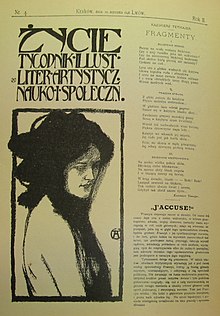Życie: Difference between revisions
m Typo and General fixing, replaced: its' → its using AWB |
No edit summary |
||
| Line 1: | Line 1: | ||
[[Image:Krakowskie.Zycie.1898.jpg|right|thumb|Edition of the ''Życie'' reporting on [[Emile Zola|Zola's]] ''[[J'Accuse]]'' letter and the [[Dreyfus affair]]]] |
[[Image:Krakowskie.Zycie.1898.jpg|right|thumb|Edition of the ''Życie'' reporting on [[Emile Zola|Zola's]] ''[[J'Accuse]]'' letter and the [[Dreyfus affair]]]] |
||
'''Życie''' was an illustrated weekly established in 1897 and published in [[Kraków]] and [[ |
'''Życie''' was an illustrated weekly established in 1897 and published in [[Kraków]] and [[Lemberg]] in [[Austria-Hungary]]. Founded by [[Ludwik Szczepański]], with time it became one of the most popular Polish literary and artistic journals. Although short-lasting (it went bankrupt in 1900), it shaped an entire generation of Polish artists and art critics, notably those associated with the so-called [[Young Poland]].<ref name="s76"/> |
||
Initially the weekly was focused on current news, politics, social and national matters in what was then the [[Austria-Hungary|Austro-Hungarian]] [[Galicia (Central Europe)|Galicia]]. Among its collaborators and correspondents in the early period were Socialist journalists [[Kazimierz Kelles-Krauz]], [[Iza Moszczeńska]] and [[Wilhelm Feldman]].<ref name="s76">{{pl icon}} {{cite book | author =Artur Hutnikiewicz | title =Młoda Polska | year =2000 | pages =76–83 | publisher =[[Wydawnictwo Naukowe PWN]] | location =Warsaw | isbn=83-01-11394-4 }}</ref> |
Initially the weekly was focused on current news, politics, social and national matters in what was then the [[Austria-Hungary|Austro-Hungarian]] [[Galicia (Central Europe)|Galicia]]. Among its collaborators and correspondents in the early period were Socialist journalists [[Kazimierz Kelles-Krauz]], [[Iza Moszczeńska]] and [[Wilhelm Feldman]].<ref name="s76">{{pl icon}} {{cite book | author =Artur Hutnikiewicz | title =Młoda Polska | year =2000 | pages =76–83 | publisher =[[Wydawnictwo Naukowe PWN]] | location =Warsaw | isbn=83-01-11394-4 }}</ref> |
||
Revision as of 19:40, 6 March 2012

Życie was an illustrated weekly established in 1897 and published in Kraków and Lemberg in Austria-Hungary. Founded by Ludwik Szczepański, with time it became one of the most popular Polish literary and artistic journals. Although short-lasting (it went bankrupt in 1900), it shaped an entire generation of Polish artists and art critics, notably those associated with the so-called Young Poland.[1]
Initially the weekly was focused on current news, politics, social and national matters in what was then the Austro-Hungarian Galicia. Among its collaborators and correspondents in the early period were Socialist journalists Kazimierz Kelles-Krauz, Iza Moszczeńska and Wilhelm Feldman.[1]
The magazine was initially a commercial failure and failed to gain enough readership. Under such circumstances the title was bought by Ignacy Sewer-Maciejowski, who offered the job of editor in chief to Stanisław Przybyszewski, who refocused the magazine to art and literary matters. Since then Życie gained much popularity thanks to publishing literary works by some of the most renown Polish writers of the epoch, including Stanisław Przybyszewski, Kazimierz Przerwa-Tetmajer, Gabriela Zapolska, Jan Kasprowicz, Maria Konopnicka, Adolf Dygasiński and Adam Asnyk.[1] Stanisław Wyspiański became the new art director of the magazine. Thanks to his efforts each edition was richly illustrated with reproductions of symbolist, impressionist and Art Nouveau paintings and prints[1]
The reformed Życie was soon turned into a bi-weekly published in large, broadsheet format, but on coated paper and in full colour. In addition to numerous reproductions and gravures published in every issue, the magazine also ordered a distinctive, elaborate font. Apart from the aforementioned authors, Wyspiański and Przybyszewski themselves, the Życie frequently also published texts by Kazimiera Zawistowska, Wincenty Brzozowski, Jerzy Żuławski and Tadeusz Rittner. It also published many works of foreign literature, including French, Czech and Scandinavian.
Among the most outstanding examples of Życies influence on contemporary Polish culture was the January 10th, 1899 issue that contained Confiteor by Stanisław Przybyszewski (a monumental essay on the role of artist) and a set of essays by Artur Górski under a common title Young Poland that gave the name to the entire modernist period in Polish literature, graphic art and music.[1]
Despite relatively high influence and readership, the Życie struggled constantly with Austro-Hungarian State Censorship Office, which on numerous occasions ordered all the copies of several consecutive issues of the journal to be confiscated and destroyed. This resulted in financial difficulties and eventual bankruptcy in 1900.[1]
Reference
- ^ a b c d e f Template:Pl icon Artur Hutnikiewicz (2000). Młoda Polska. Warsaw: Wydawnictwo Naukowe PWN. pp. 76–83. ISBN 83-01-11394-4.
See also
